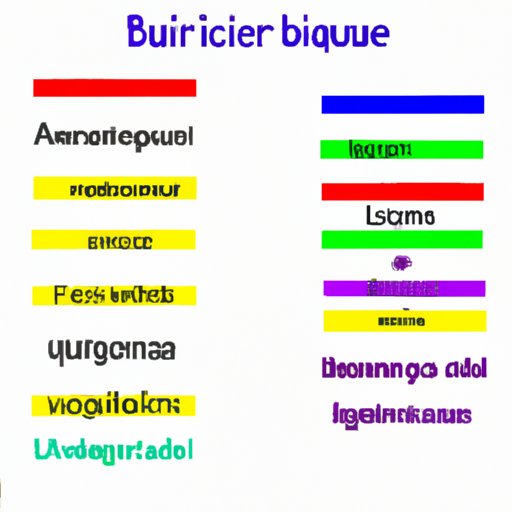Exploring Brazilian Speak: Beyond Portuguese
Brazil is widely recognized as the largest country in South America and one of the major economies of the world. The country is also known for its lively and colorful culture, famous for its samba, Carnival, and its rich history. However, what most people do not know about Brazil is its multilingualism. Brazil is home to many different languages, and it is estimated that over 200 languages are spoken in the country. To solve the language problem and promote inclusivity, it is essential to delve into Brazil’s multilingualism to understand the different languages spoken beyond Portuguese.
Exploring the Multilingualism of Brazil: An Overview of the Country’s Many Languages
Brazil’s geography has a significant influence on its linguistic diversity. The country is rich in natural resources and covers over 3 million square miles, making it an immense and diverse country. The diversity in climate and topography make it a suitable place for diverse cultures and languages to thrive. Brazil’s linguistic diversity is also a result of its complex colonial history. Brazil was a Portuguese colony for over three centuries. Slaves from Africa and immigrants from Europe worked and settled in Brazil, leading to a cultural blend of diverse people, languages, and customs.
According to the Brazilian Constitution, the official language of the country is Portuguese. It is estimated that over 98% of the population speaks Portuguese as their primary language. However, Brazil’s complex history has led to the development of other languages in different parts of the country. These languages are divided into two broad categories: indigenous languages and immigrant languages.
Portuguese and Beyond: The Different Languages Spoken in Brazil
Portuguese is the primary language spoken in Brazil. However, there are significant variations in the way Portuguese is spoken in different parts of the country, leading to the development of different dialects. The Brazilian Portuguese dialects have been influenced by indigenous languages such as Tupi-Guarani and African languages such as Yoruba and Bantu, as well as by European languages like Italian and German brought to Brazil by immigrants.
Indigenous languages have been present in Brazil for over 6,000 years and are still spoken by around 305 indigenous groups in the country. The most widely spoken indigenous languages in Brazil are Nheengatu, Guarani-Kaiowá, and Kaingang. These languages have a significant influence on Brazilian Portuguese, particularly vocabulary, grammar, and pronunciation.
Brazil’s Diverse Linguistic Landscape: A Look Beyond Portuguese
The African influence in Brazil is significant and particularly pronounced in the country’s northeastern region. In the past, Brazil was the largest recipient of African slaves in the world. The slaves brought their culture and languages, which mingled with Portuguese and “European Brazilian” culture. As a result, African languages such as Yoruba and Bantu continue to be spoken widely throughout Brazil.
Immigration has also played a significant role in shaping the linguistic landscape of Brazil. Brazil has been a melting pot of different cultures and languages from all over the world. Immigrants from Italy, Germany, Japan, and other countries brought their languages, which have significant influence and are still spoken in the country.
Beyond the Samba and Carnival: The Many Languages of Brazil
It is essential to understand and recognize the cultural significance of different languages spoken in Brazil. The country’s rich linguistic diversity plays a crucial role in shaping Brazilian music, literature, and other art forms. For example, samba, Brazil’s national dance, has its roots in the African languages spoken in Brazil. Similarly, Brazilian literature reflects the country’s linguistic diversity, with many authors writing in languages other than Portuguese, such as Yoruba, Guarani, and German.
Brazilian music has been influenced by diverse genres from around the globe. For example, the northeast region of Brazil has a strong influence from African music, while Brazilian jazz blends together American jazz and samba. The diversity of musical styles in Brazil is a direct reflection of the country’s linguistic landscape and the blending of different cultures and languages.
From Tupi to Portuguese: The Rich Linguistic History of Brazil
Brazil’s linguistic history is a rich and complex mix of cultures, languages, and customs. The country’s indigenous languages, spoken for thousands of years, have a significant impact on Brazilian Portuguese, particularly in vocabulary, grammar, and pronunciation.
It is essential to preserve and study Brazil’s linguistic history to understand the country’s diverse and multilingual identity truly. Learning and valuing indigenous languages and immigrant languages spoken in Brazil can also lead to inclusivity and a deeper appreciation for the country’s diverse cultures and identities.
Conclusion
Brazil’s rich and complex linguistic landscape highlights the importance of recognizing and celebrating language diversity within a country. Brazil’s history shows how diverse languages, cultures, and customs can come together to create a unique and vibrant society. To solve the language problem and promote inclusivity, it is essential to appreciate the numerous languages spoken in Brazil beyond Portuguese. We need to understand the cultural significance of different languages and how they shape Brazil’s music, literature, and other art forms. Brazil’s linguistic history is a critical aspect of the country’s identity, deserving of preservation and study.
